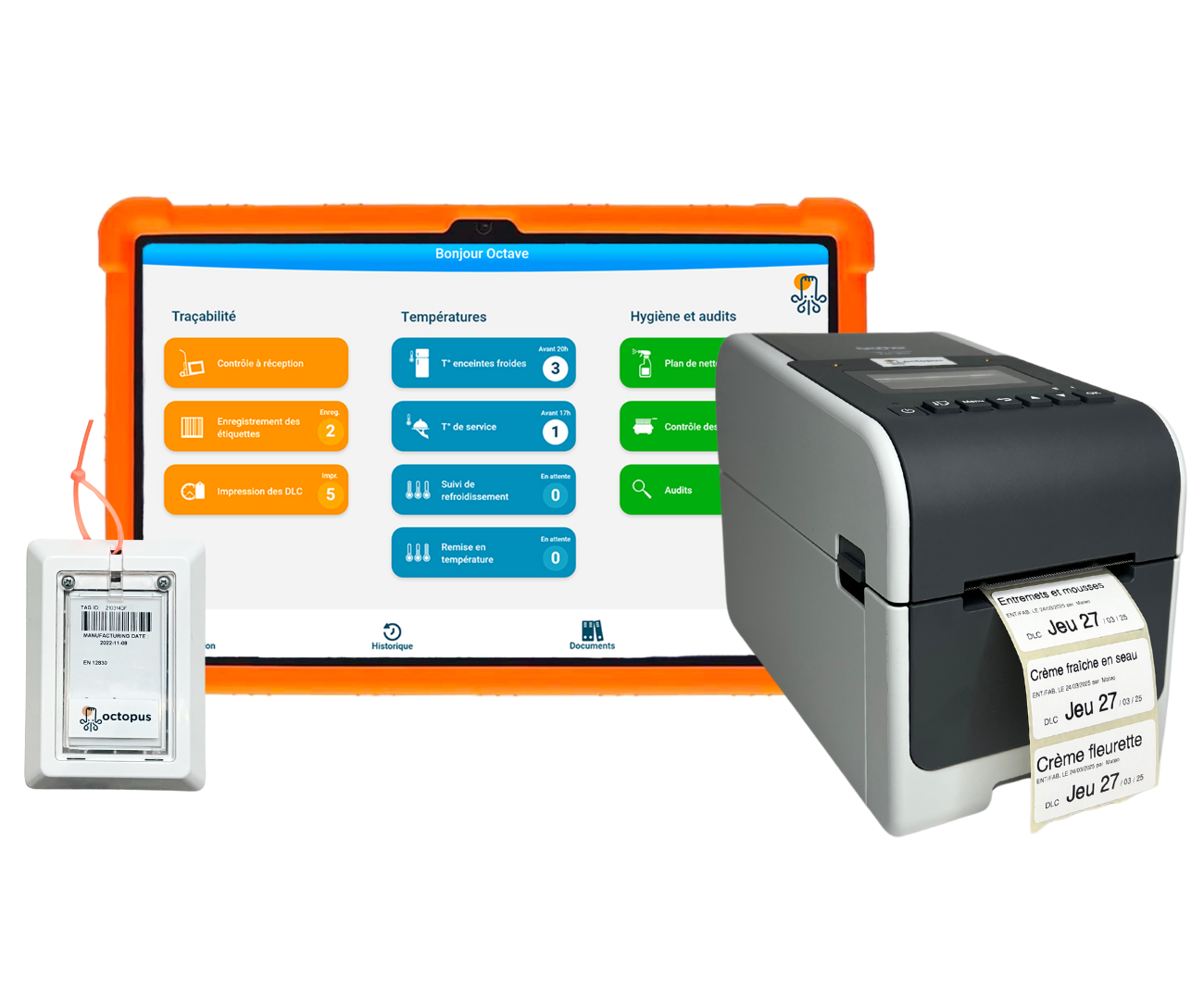Affichage origine des viandes : pdf gratuit
Quel est l’affichage obligatoire pour l’origine des viandes ? 🎯
En tant que professionnel de la restauration, ou artisan boucher-charcutier, vous avez l’obligation d’afficher l’origine des viandes que vous servez ou vendez.
Depuis 2022, la réglementation a évolué à 2 reprises ! Alors suivez le guide pour comprendre ce que vous devez indiquer sur vos affichages obligatoires pour l’origine des viandes, et être en règle :
Pour quelles viandes l’affichage est-il obligatoire ? 🥩
Jusqu’à présent vous deviez déjà afficher l’origine de vos viandes pour les viandes bovines, le porc, les ovins et les volailles, achetées crues ou surgelées.
L’affichage de l’origine des viandes autres que bovines, est liée au décret du 27 janvier 2022. Ce décret stipule que l’étiquetage de l’origine des viandes (bœuf, volaille, mouton, agneau, porc) servie en restauration hors domicile devra mentionner le pays d’élevage et le pays d’abattage, qu’il s’agisse de viandes fraîches réfrigérées, congelées ou surgelées.
Cette nouvelle obligation répond à une attente forte des consommateurs de transparence et de traçabilité sur l’origine des produits qu’ils consomment.
Cet affichage ou étiquetage obligatoire est valable pour la consommation sur place et la consommation à emporter.
Quel type de préparations répondent à cet affichage obligatoire ?
Jusqu’à présent seules les viandes achetées crues faisaient l’objet d’un affichage obligatoire sur leur origine. Par exemple : un steak haché, une entrecôte, une volaille ou un rôti.
Depuis le 4 mars 2024, un nouveau décret sur l’affichage obligatoire de l’origine des viandes est venu compléter vos obligations d’affichage : Vous devez afficher l’origine des viandes inclues des préparations de viandes achetées déjà préparées ou cuisinées.
Par exemple : des nuggets, des saucisses, de la charcuterie, des raviolis, une sauce bolognese, une quiche aux lardons, une farce etc.
Téléchargez votre pdf gratuit pour l’affichage de l’origine des viandes ⤵️
Nous avons le plaisir de vous offrir, pour votre restaurant ou votre boucherie, votre tableau à imprimer pour l’affichage de l’origine des viandes : téléchargez votre affichage de l’origine des viandes en pdf gratuitement en remplissant le formulaire ci après 👇
Que présenter en cas de contrôle sanitaire ? 🎟️
Concernant la traçabilité des viandes vous avez plusieurs obligations :
- Obligation de traçabilité
- Obligation d’affichage de l’origine
Quelles sont mes obligations concernant la traçabilité ?
Concernant la traçabilité, vous devez être capable de retracer le chemin de vos viandes depuis votre approvisionnement jusqu’au moment ou vous les servez à votre convive ou client.
Concrètement, vous devez, entre autre:
1- Lors du contrôle à réception : lorsque vous recevez de la marchandise, vous avez une obligation de traçabilité. Vous devez conserver votre bon de livraison. Ceci vous permet de retracer la date de réception de la marchandise dans votre restaurant ou votre boucherie, ainsi que les quantités reçues et des informations sur le produit permettant de l’identifier. Vous pouvez conserver votre bon de livraison de manière physique ou digitale avec une application HACCP. Peut importe le mode de conservation, ou d’organisation, l’important est le résultat : être capable de retracer l’origine de vos viandes.
2- Lors de la production : lorsque vous réalisez votre mise en place, ou votre service, vous devez conserver les informations des étiquettes de traçabilité de toutes les denrées que vous utilisez. Soyez particulièrement vigilant sur les produits sensibles, la viande étant considérée comme un produit sensible, et les viandes hachées comme des produits très sensibles. Les informations à conserver sur vos étiquettes de traçabilité sont à minima les suivantes :
- Nom du produit
- Numéro de lot (souvent lié à la DLC)
- Estampille sanitaire, permettant d’identifier la provenance du laboratoire de production ou de l’abattoir.
- Origine de la viande si indiquée
- DLC pour prouver que le produit mis en vente n’était pas périmé.
La conservation du code bar classique (EAN 13) est inutile, il ne renseigne en rien sur la traçabilité ou l’origine de votre viande.
3- Lors du stockage de vos ingrédients et préparations de viande:
- Si vous avez déconditionné des produits : vous devez étiqueter leur nouveau contenant avec les informations suivantes sur une étiquette de DLC secondaire : Qui, Quoi, date de déconditionnement, DLC secondaire. Par exemple pour une viande dite sensible, type steak haché, la DLC sera de J+1.
- Ouverts des emballages de produits : vous devez étiqueter l’emballage ouvert avec les informations suivantes : Qui, Quoi, date d’ouverture ou d’entamer, DLC secondaire. La DLC secondaire est à trouver sur l’emballage en fonction des informations fournies par le fabricant.
- Réalisation d’une mise en place ou préparation: de la même manière il faut étiqueter vos productions : Qui, Quoi, date de production, DLC secondaire. Pour une préparation maison, la réglementation vous impose de conserver à J+3 maximum en l’absence d’analyse microbiologique. Les viandes hachées ont une DLC maximum de J+1 à une température de conservation de 2°C maximum. Pour les viandes sous-vide, la réglementation ne donne pas d’informations. Vous pouvez vous référez au bonnes pratiques dans votre secteur (GBPH), ou demander conseil à votre fabricant de machines sous-vide.
Durée de conservation : Les informations de traçabilité des produits à DLC courte doivent être conservées 1 an. C’est 5 ans pour les produits ayant une conservation longue : DDM (Date de Durabilité Minimale), par exemple les conserves, ou les surgelés. Vous devez conserver vos informations soit en format papier, soit sur une application HACCP. Vous pouvez avec Octopus HACCP, conserver la traçabilité de vos contrôles à réception, prendre toutes vos étiquettes de traçabilité en photo, les classer et les archiver automatiquement, imprimer vos étiquettes de DLC secondaires en 1 clic.
Comment réaliser l’affichage de l’origine des viandes ?
Il n’y a pas de format imposé pour l’affichage. l’important est que le consommateur accède à l’information facilement. Vous pouvez utiliser l’affiche pdf gratuite sur l’origine des viandes que vous pouvez télécharger en remplissant le formulaire ci-dessus, ou sur une ardoise.
Vous pouvez indiquer l’origine dans vos menus (attention aux changement d’origine en cours de carte), ou étiquette sur vos produits lorsqu’ils sont vendus emballés.
Lors d’un contrôle d’hygiène, la Police SSA vérifiera la cohérence entre vos approvisionnements et les informations affichées. Pensez-à les mettre à jour régulièrement !
Quelles sont les sanctions en cas de défaut d’affichage de l’origine des viandes ? 👨⚖️📝
Lors d’un contrôle sanitaire ou des fraudes, il peuvent vous verbaliser pour différentes raisons concernant l’affichage obligatoire des viandes :
1/ Vous ne réalisez pas d’affichage de l’origine des viandes
2/ Les informations affichées ne correspondent pas à la réalité : dans ce cas il s‘agit d’informations mensongères. Par exemple : origine France, pour le viande venant de Pologne.
3/ Les informations affichées sont partielles. Par exemple vous n’affichez pas l’origine de la viande de volaille, ou de vos préparations alors que vous affichez celle du bœuf.
Dans ce cas, et selon le degré de pédagogie, ainsi que des autres infractions constatées, vous êtes passibles d’une amende de 1500€ minimum.
Exception : La seule exception concernant l’affichage de l’origine des préparations de viande achetées ou les produits achetés contenant de la viande, est si cette information n’est pas présente sur l’emballage du produit que vous avez acheté (vous n’allez pas l’inventer…)
Toute l’équipe d’Octopus HACCP espère que vous y voyez désormais plus clair sur cette obligation d’affichage !
Besoin d’accompagnement sur l’HACCP ? Notre équipe saura vous proposer l’application HACCP qui correspond à vos besoins. Contactez-nous !
Je contacte Octopus HACCP
Nous vous aidons à être prêt pour les contrôles sanitaire
Avec l’application Octopus HACCP, digitalisez vos relevés d’hygiènes.
- Prenez simplement en photo vos étiquettes de traçabilité
- Contrôlez les températures de vos enceintes froides gâces à nos capteurs connectés
- Mettez en place et suivez facilement vos plans de nettoyage.
Avec notre application, accédez à tous vos données en un clic grâce au bouton contrôle sanitaire.



